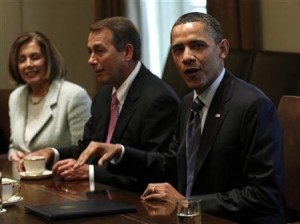 Lawmakers and the White House seized on Standard & Poor’s revised U.S. credit outlook on Monday as ammunition in their fierce deficit reduction debate, and showed no signs of moving toward a quick deal.
Lawmakers and the White House seized on Standard & Poor’s revised U.S. credit outlook on Monday as ammunition in their fierce deficit reduction debate, and showed no signs of moving toward a quick deal.
S&P’s move — changing its outlook on the U.S. rating to negative from stable — pushes President Barack Obama and Republicans to agree on ways to slash the deficit or face the potential loss of Washington’s coveted triple-A credit rating.
Stocks fell and policy makers fretted over the move, but neither Democrats nor Republicans signaled changes that would indicate a breakthrough on spending cuts in the near future.
“It drives home the fact that for all the talk in Washington, there is nothing on the table that is moving,” said Sean West, a fiscal policy analyst for investors at the Eurasia Group, referring to the S&P announcement.
Obama and Republican congressional leaders have sparred for weeks over how to tackle the deficit, which is projected to hit $1.4 trillion this fiscal year.
Both sides have unveiled competing plans to bring deficits down to sustainable levels by the end of the decade, but they differ sharply on how to reach those goals. S&P zeroed in on these differences as a risk that Washington would not tackle long-term U.S. fiscal woes by 2013.
Obama says America’s wealthy should pay a higher share of the tax burden and also proposes cuts in spending on both domestic programs and the military to help narrow the deficit.
“We’ve got to start making sure we’re living within our means, both medium term and long term,” the president told broadcaster WRAL in Raleigh, North Carolina, as part of a blitz of local television interviews he gave on Monday.
“There is a way of doing that where we cut about $2 trillion worth of spending, and we raise about $1 trillion worth of revenue, mainly from folks like myself who can afford to pay a little bit more, closing loopholes, making the tax system fairer,” he said. Obama laid out these goals in a deficit speech last week.
Republicans are instead pushing for deeper spending cuts than those proposed by Obama and the Democrats, and advocate making permanent Bush-era tax cuts for American families earning more than $250,000 a year, which Obama opposes.
The White House said Vice President Joe Biden will lead a deficit reduction meeting with members of Congress on May 5, after they return from recess over Passover and Easter.
“I’m glad they put the warning out,” said Joseph Antos, a scholar at the American Enterprise Institute.
“I’m worried that the people who should understand this will have elections on their mind … and may not want to do what I think is the right thing in the next few months.”
The White House, which last week laid out its plan to slash the budget deficit by $4 trillion over 12 years, said the political process would outperform S&P’s expectations.
“We simply believe that the prospects (for a deal) are better,” said Jay Carney, Obama’s spokesman.
“Any call for a bipartisan agreement on deficit reduction, on fiscal reform, is a welcome one. And in that context, I think that (the S&P move) adds to what we believe is some momentum toward that end.”
IMMEDIATE BATTLE
While S&P’s action added urgency to the deficit debate, it also amplified a more immediate battle over whether Republicans will back Obama’s call to raise the debt ceiling.
Representative Eric Cantor, the No. 2 House Republican, called S&P’s changed credit outlook “a wake-up call” against those seeking to “blindly increase” the U.S. debt limit.
He said the move made clear that any increase in the debt limit must be accompanied by “meaningful fiscal reforms that immediately reduce federal spending and stop our nation from digging itself further into debt.”
U.S. House Democratic Leader Nancy Pelosi said the threatened downgrade showed Democrats and Republicans must “demonstrate our commitment to reducing our deficit through shared responsibility.”
Republicans unveiled a plan earlier this month to reduce deficits over the next 10 years by $4.4 trillion by cutting spending and overhauling government-run health programs for the poor and elderly. Democrats slammed the plan.
Polls show Americans are deeply worried about the state of the country’s finances, which will be one of the driving issues in the 2012 presidential and congressional elections.
Lawmakers backed by the conservative Tea Party movement, which helped Republicans take control of the House in last year’s elections, said S&P’s move was an endorsement of their budget-cutting platform.
“It is a vindication of the Tea Party and their stance that we are spending too much,” said Republican Representative Blake Farenthold, a member of the House Tea Party Caucus.
The White House, however, pointed to Moody’s Investors Service, S&P’s main competitor, which said both sides’ plans for deficit reduction represent a “potential change in the direction of fiscal policy (that) is credit positive for the U.S. federal government.”
WASHINGTON (Reuters) – By Jeff Mason and Kim Dixon
(Additional reporting by Alister Bull, Andy Sullivan, Thomas Ferraro, Susan Cornwell, Donna Smith, and Steve Holland; Editing by Deborah Charles and Jackie Frank))





